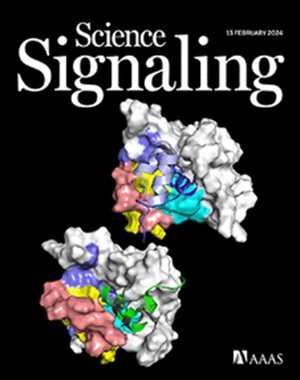The lncRNA Gas5 is an activity-responsive scaffold that mediates cAMP-dependent synaptic plasticity
IF 6.6
1区 生物学
Q1 BIOCHEMISTRY & MOLECULAR BIOLOGY
引用次数: 0
Abstract
Changes in the transcriptome are critical in shaping the structural plasticity of neurons, which underpins learning and long-term memory storage. Here, we explored the effect of two opposing, plasticity-associated pathways—cAMP second-messenger signaling and metabotropic glutamate receptor (mGluR1 and mGluR5) signaling—on the transcriptome in hippocampal neurons and how these pathways operate in distinct and coordinated manners to induce structural changes. Integration of transcriptome data and molecular pathway analysis identified central “hub” genes that were rapidly induced by cAMP and/or mGluR1/5 in hippocampal neurons. These included the long noncoding RNA (lncRNA) Gas5, whose expression was induced specifically by cAMP and which was targeted to dendrites by the kinesin motor protein KIF1A. In the dendrites, Gas5 interacted with various proteins and coding and noncoding RNAs associated with synaptic function and plasticity, and these interactions were altered by cAMP signaling. Gas5 interacted with the microRNA miR-26a-5p and sequestered it from several of its mRNA targets associated with neuronal function and whose translation was induced by cAMP. Gas5 was critical for excitatory synaptic transmission induced by cAMP but not those induced by mGluR1/5. Furthermore, Gas5 deficiency impaired dendritic branching and synapse morphology, and Gas5 abundance was decreased in the hippocampus of a mouse model of Alzheimer’s disease. Together, these findings provide insight into the transcriptional networks involved in synaptic plasticity and a lncRNA interactome that mediates dendritically localized regulation of excitatory synaptic transmission and neuronal architecture.

lncRNA Gas5是一种活性反应支架,介导camp依赖性突触可塑性
转录组的变化对神经元结构可塑性的形成至关重要,而神经元结构可塑性是学习和长期记忆储存的基础。在这里,我们探索了两个相反的,可塑性相关的途径- camp第二信使信号和代谢性谷氨酸受体(mGluR1和mGluR5)信号-对海马神经元转录组的影响,以及这些途径如何以不同的和协调的方式运作以诱导结构变化。整合转录组数据和分子通路分析确定了cAMP和/或mGluR1/5在海马神经元中快速诱导的中心“枢纽”基因。其中包括长链非编码RNA (lncRNA) Gas5,其表达被cAMP特异性诱导,并被运动蛋白KIF1A靶向树突。在树突中,Gas5与各种蛋白质以及与突触功能和可塑性相关的编码和非编码rna相互作用,这些相互作用被cAMP信号改变。Gas5与microRNA miR-26a-5p相互作用,并将其从与神经元功能相关的几个mRNA靶标中分离出来,这些靶标由cAMP诱导翻译。Gas5在cAMP诱导的兴奋性突触传递中起关键作用,而在mGluR1/5诱导的兴奋性突触传递中不起作用。此外,在阿尔茨海默病小鼠模型中,Gas5缺乏损害了树突分支和突触形态,并且在海马中Gas5丰度降低。总之,这些发现为突触可塑性的转录网络和介导兴奋性突触传递和神经元结构的树突局部调节的lncRNA相互作用组提供了深入的见解。
本文章由计算机程序翻译,如有差异,请以英文原文为准。
求助全文
约1分钟内获得全文
求助全文
来源期刊

Science Signaling
BIOCHEMISTRY & MOLECULAR BIOLOGY-CELL BIOLOGY
CiteScore
9.50
自引率
0.00%
发文量
148
审稿时长
3-8 weeks
期刊介绍:
"Science Signaling" is a reputable, peer-reviewed journal dedicated to the exploration of cell communication mechanisms, offering a comprehensive view of the intricate processes that govern cellular regulation. This journal, published weekly online by the American Association for the Advancement of Science (AAAS), is a go-to resource for the latest research in cell signaling and its various facets.
The journal's scope encompasses a broad range of topics, including the study of signaling networks, synthetic biology, systems biology, and the application of these findings in drug discovery. It also delves into the computational and modeling aspects of regulatory pathways, providing insights into how cells communicate and respond to their environment.
In addition to publishing full-length articles that report on groundbreaking research, "Science Signaling" also features reviews that synthesize current knowledge in the field, focus articles that highlight specific areas of interest, and editor-written highlights that draw attention to particularly significant studies. This mix of content ensures that the journal serves as a valuable resource for both researchers and professionals looking to stay abreast of the latest advancements in cell communication science.
 求助内容:
求助内容: 应助结果提醒方式:
应助结果提醒方式:


